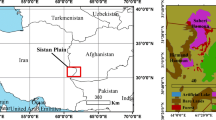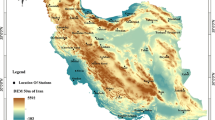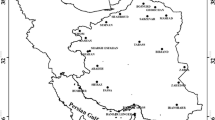Abstract
The dynamic changes characteristics of salt dust storm in the Ebinur Lake of Xinjiang were investigated using the monitoring data during 1957–2007 of atmospheric dust storm and floating dust from four meteorological stations surrounding the dry lakebeds, and the gray correlation analysis method was used to calculate the correlation degree between annual dust storm days and meteorological and socioeconomic factors. The results showed that salt dust storm in the Ebinur Lake region presented a fluctuating process during 1957–2007, in which 1975 and 2000 were the two cut-off points. During 1975–2000, there were very frequent storms, and the average annual number of salt dust storm days was 10–48, while the average annual number of storm days was not more than 12 both before 1975 and after 2000. The annual variation of salt dust storm displayed a double-peak pattern, of which storm in spring accounted for 62–90 % of the total dust storm days of a year, and that in autumn accounted for 7–13 %. Among the meteorological factors, strong winds had the greatest impact on salt dust storm, followed by temperature and precipitation. For the anthropogenic factors, agricultural acreage exhibited the strongest influence on salt dust storm, followed by lake surface area and population number, while livestock number showed the smallest effect.




Similar content being viewed by others
References
Abuduwaili J, Mu GJ (2006) Eolian factor in the process of modern salt accumulation in western Dzungaria, China. Eurasian Soil Sci 39:367–376
Abuduwaili J, Gabchenko M, Xu J (2008) Eolian transport of salts—a case study in the area of Lake Ebinur (Xinjiang, northwest China). J Arid Environ 72(10):1843–1852
Abuduwaili J, Liu D, Wu G (2010) Saline dust storms and their ecological impacts in arid regions. J Arid Land 2(2):144–150
Cahill TA, Gill TE, Reid JS, Gearhart EA, Gillette DA (1996) Saltating particles, playa crusts and dust aerosols at Owens (dry) Lake, California. Earth Surf Process Land 21(7):621–639
Dong Y, Duan Z (2008) A new determination method for identification coefficient of grey relational grade. J Xi’an Univ Arch Tech (Natural Science Edition) 40(4):589–592 (in Chinese)
Gill TE (1996) Eolian sediments generated by anthropogenic disturbance of playas: human impacts on the geomorphic system and geomorphic impacts on the human system. Geomorphology 17(1):207–228
Goudie A, Wells G (1995) The nature, distribution and formation of pans in arid zones. Earth Sci Rev 38(1):1–69
Jeffrey Kuo C-F, Su T-L, Jhang P-R, Huang C-Y, Chiu C-H (2011) Using the Taguchi method and grey relational analysis to optimize the flat-plate collector process with multiple quality characteristics in solar energy collector manufacturing. Energy 36(5):3554–3562
Lin J, Lin C (2002) The use of the orthogonal array with grey relational analysis to optimize the electrical discharge machining process with multiple performance characteristics. Int J Mach Tools Manuf 42(2):237–244
Liu D, Abuduwaili J, Lei J, Wu G (2011a) Deposition rate and chemical composition of the Aeolian dust from a bare saline playa, Ebinur Lake, Xinjiang, China. Water Air Soil Pollut 218(1–4):175–184
Liu D, Abuduwaili J, Lei J, Wu G, Gui D (2011b) Wind erosion of saline playa sediments and its ecological effects in Ebinur Lake, Xinjiang, China. Environ Earth Sci 63(2):241–250
Liu J, Man Y, Liu Y (2014) Temporal variability of PM10 and PM2.5 inside and outside a residential home during 2014 Chinese Spring Festival in Zhengzhou, China. Nat Hazards. doi:10.1007/s11069-014-1157-9
Mu G, Yan S, Jilil A, He Q, Xai X (2002) Wind erosion at the dry-up bottom of Aiby Lake. Sci China Ser D 45(1):157–164
Reynolds RL, Yount JC, Reheis M, Goldstein H, Chavez P, Fulton R, Whitney J, Fuller C, Forester RM (2007) Dust emission from wet and dry playas in the Mojave Desert, USA. Earth Surf Process Land 32(12):1811–1827
Singer A, Zobeck T, Poberezsky L, Argaman E (2003) The PM10 and PM2.5 dust generation potential of soils/sediments in the Southern Aral Sea Basin, Uzbekistan. J Arid Environ 54(4):705–728
Wang K, Liu YN (2014) Can Beijing fight with haze? lessons can be learned from London and Los Angeles. Nat Hazards 72(2):1265–1274
Acknowledgments
This work was funded by the National Natural Science Foundation of China (41201539), the China Postdoctoral Science Foundation (2013M530439), National Key Technology R&D Program of China (2011BAC02B03), the Personnel training program of Light west of the Chinese Academy of Sciences and the Program of Higher-level talents of Inner Mongolia University.
Author information
Authors and Affiliations
Corresponding author
Rights and permissions
About this article
Cite this article
Liu, D., Abuduwaili, J. & Wang, L. Salt dust storm in the Ebinur Lake region: its 50-year dynamic changes and response to climate changes and human activities. Nat Hazards 77, 1069–1080 (2015). https://doi.org/10.1007/s11069-015-1642-9
Received:
Accepted:
Published:
Issue Date:
DOI: https://doi.org/10.1007/s11069-015-1642-9




